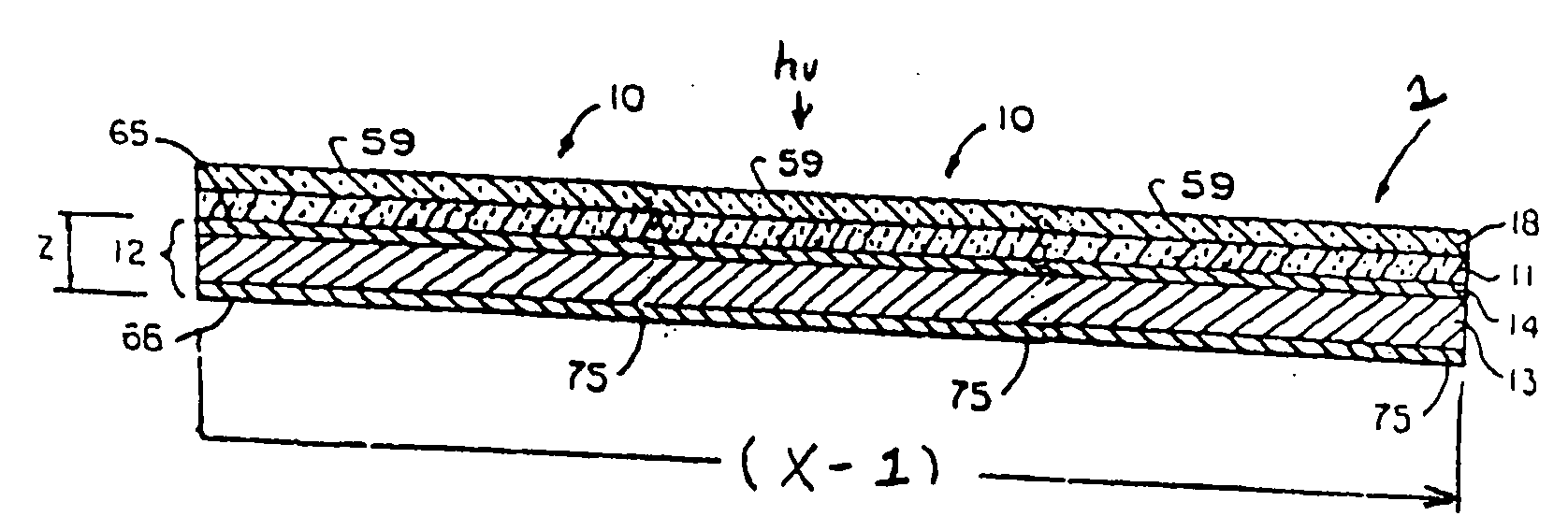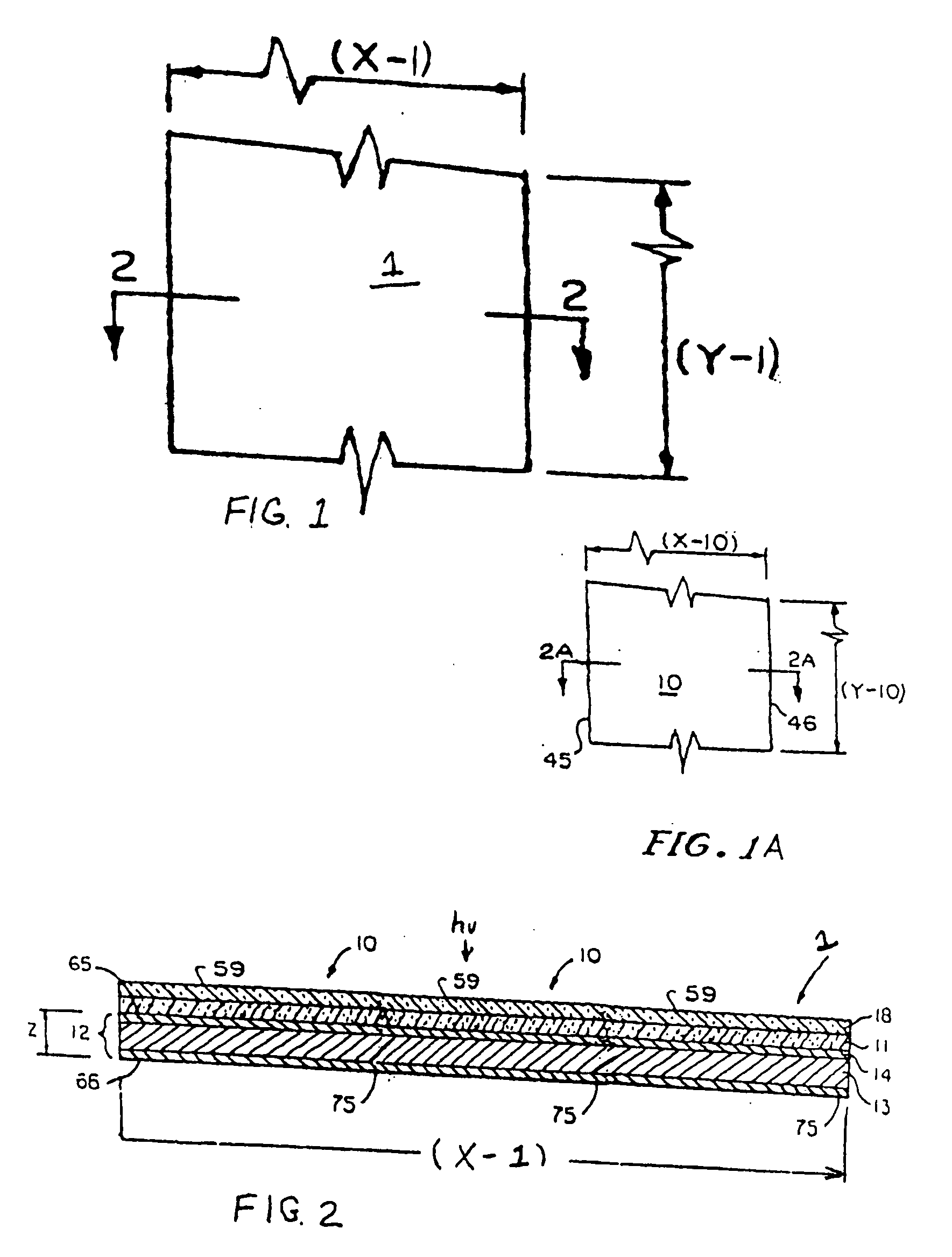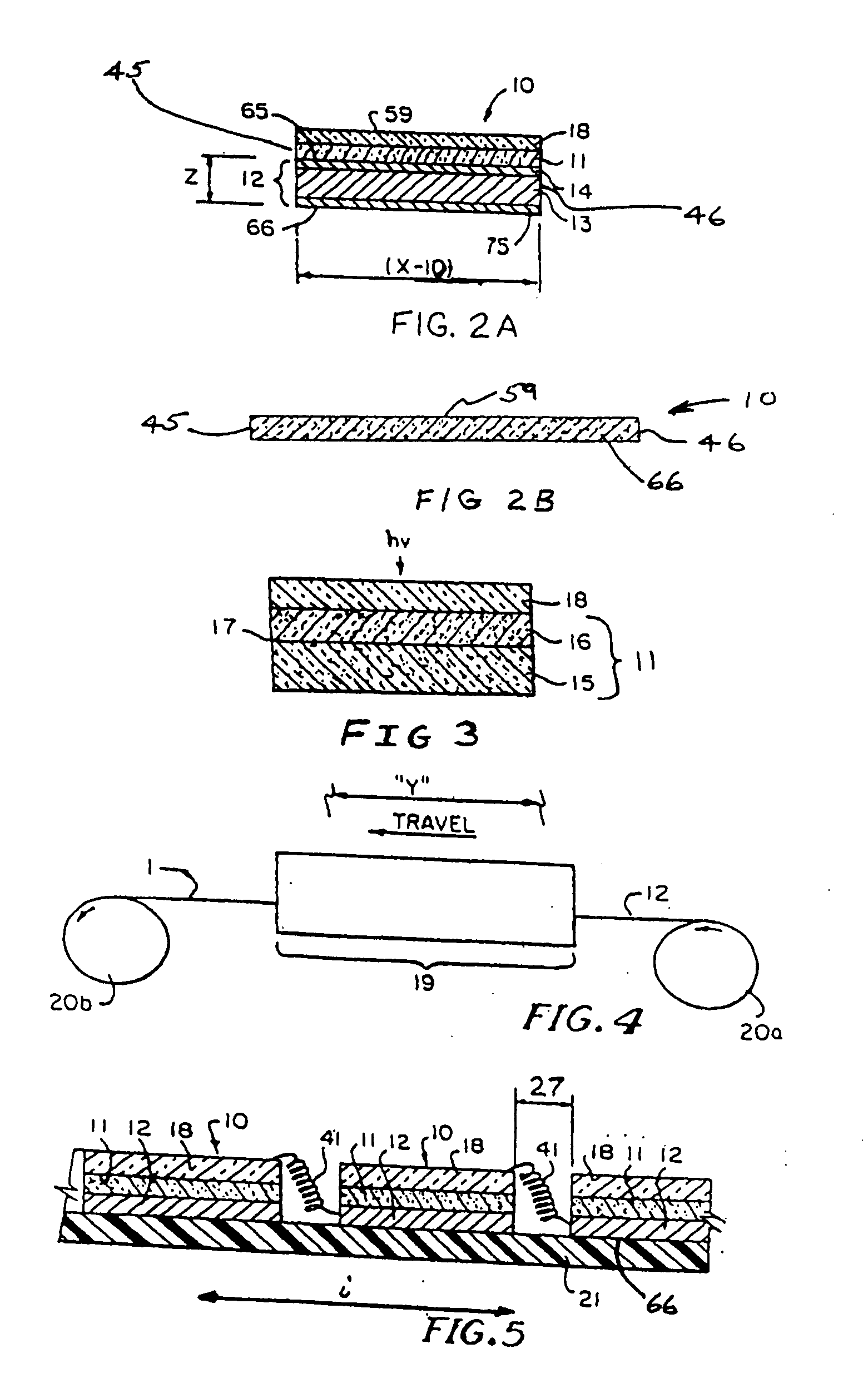Despite significant improvements in individual
cell conversion efficiencies for both single
crystal and thin film approaches, photovoltaic energy collection has been generally restricted to applications having low power requirements.
One factor impeding development of bulk power systems is the problem of economically collecting the energy from an extensive collection surface.
It is readily recognized that making effective, durable series connections among multiple small cells can be laborious, difficult and expensive.
However, a challenge still remains regarding subdividing the
expansive films into individual cells followed by interconnecting into a series connected array.
The electrical resistance of thin vacuum metallized
layers significantly limits the active area of the individual interconnected cells.
However, despite the fact that use of a
metal foil allows high temperature
processing in roll-to-roll fashion, the subsequent
interconnection of individual cells effectively in an interconnected array has proven difficult, in part because the
metal foil substrate is electrically conducting.
These operations add considerably to the final interconnected array cost.
First, many of the chemical elements involved in the best photovoltaic semiconductors are expensive and environmentally unfriendly.
This removal subsequent to controlled deposition involves containment, dust and
dirt collection and disposal, and possible
cell contamination.
This is not only wasteful but considerably adds to expense.
Secondly, the removal processes are difficult to control dimensionally.
Thus a significant amount of the valuable photovoltaic
semiconductor is lost to the removal process.
Ultimate module efficiencies are further compromised in that the spacing between adjacent cells grows, thereby reducing the effective active collector area for a given module area.
A further unsolved problem which has thwarted production of
expansive surface photovoltaic modules is that of collecting the photogenerated current from the top, light incident surface.
These
small cell widths demand very fine interconnect area widths, which dictate delicate and sensitive techniques to be used to electrically connect the top TCO surface of one
cell to the bottom
electrode of an adjacent series connected cell.
Furthermore, achieving good stable
ohmic contact to the TCO cell surface has proven difficult, especially when one employs those sensitive techniques available when using the TCO only as the top collector
electrode.
One notes that this approach involves use of expensive silver and requires the photovoltaic semiconductors tolerate the high fusion temperatures.
This wire approach requires positioning and fixing of multiple fine fragile wires which makes
mass production difficult and expensive.
These approaches require the use of relatively expensive inks because of the
high loading of finely divided silver.
In addition, batch printing on the individual cells is laborious and expensive.
The process is very sensitive to processing variables used to fabricate the plastic substrate, limiting applications to carefully prepared parts and designs.
In addition, the many steps employing harsh chemicals make the process intrinsically costly and environmentally difficult.
Finally, the sensitivity of ABS plastic to
liquid hydrocarbons has prevented certain applications.
This is a misnomer in the strict sense, since ABS (and other nonconductive polymers) are incapable of accepting an electrodeposit directly and must be first metallized by other means before being finally coated with an electrodeposit.
None of these attempts at simplification have achieved any recognizable commercial application.
However, attempts to make an acceptable electroplateable
polymer using the relatively small
metal containing fillers alone encounter a number of barriers.
First, the most conductive fine metal containing fillers such as silver are relatively expensive.
The loadings required to achieve the particle-to-particle proximity to achieve acceptable
conductivity increases the cost of the
polymer / filler blend dramatically.
The metal containing fillers are accompanied by further problems.
They tend to cause deterioration of the mechanical properties and processing characteristics of many resins.
This significantly limits options in resin selection.
A required heavy loading of metal filler severely restricts ability to manipulate processing properties in this way.
A further problem is that metal fillers can be
abrasive to processing machinery and may require specialized screws, barrels, and the like.
Despite being
electrically conductive, a simple metal-filled polymer offers no assured bonding mechanism to produce adhesion of an electrodeposit since the metal particles may be encapsulated by the resin binder, often resulting in a resin-rich “
skin”.
However, here the metal particles are generally encapsulated by the resin binder, often resulting in a resin rich “
skin”.
For the above reasons,
electrically conductive polymers employing metal fillers have not been widely used as bulk substrates for electroplateable articles.
An additional physical obstacle confronting practical
electroplating onto electrically conductive polymers is the initial “bridge” of electrodeposit onto the surface of the electrically
conductive polymer.
However, if the
contact resistance is excessive or the substrate is insufficiently conductive, the electrodeposit current favors the rack tip to the point where the electrodeposit will not bridge to the substrate.
Moreover, a further problem is encountered even if specialized
racking or cathodic contact successfully achieves electrodeposit bridging to the substrate.
The conductive polymeric substrate may be relatively limited in the amount of electrodeposition current which it alone can convey.
In a fashion similar to the bridging problem discussed above, the electrodeposition current favors the electrodeposited metal and the lateral growth can be extremely slow and erratic.
This restricts the size and “growth length” of the substrate conductive pattern, increases plating costs, and can also result in large non-uniformities in electrodeposit integrity and thickness over the pattern.
These factors of course often work against achieving the desired result.
A fundamental problem remaining unresolved by the Adelman teaching is the relatively
high resistivity of carbon loaded polymers.
Thus, the electrodeposit bridging and coverage rate problems described above remained unresolved by the Adelman teachings.
Said material addition may have insignificant affect on the current
carrying capacity of the structure (i.e. it does not appreciably reduce resistivity or increase thickness).c. Nevertheless, inclusion of said material greatly increases the speed at which an electrodeposited metal laterally covers the electrically conductive surface.
One or more growth rate accelerators may be present in a directly electroplateable resin (DER) to achieve combined, often synergistic results.
Due to multiple performance problems associated with their intended end use, none of the attempts identified above to directly electroplate electrically conductive polymers or plastics has ever achieved any recognizable commercial success.
One readily recognizes that the demand for such functional applications for electroplated articles is relatively recent and has been particularly explosive during the past decade.
Treatment of both sides of the substrate in a roll to roll process may adversely affect the surface of the DER material and may lead to deterioration in plateability.
For example, it has been observed that primers on both sides of a roll of PET film have adversely affected plateability of DER inks printed on the PET.
Such selective positioning of metals is often expensive and difficult.
 Login to View More
Login to View More 


